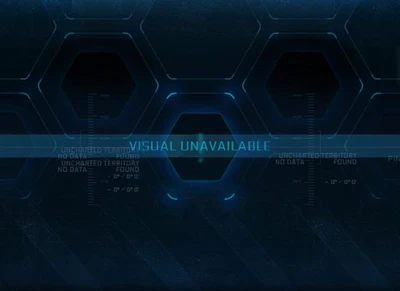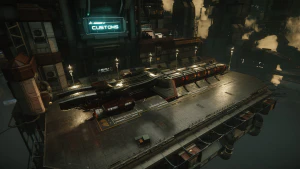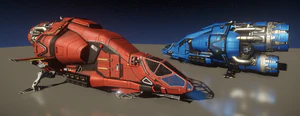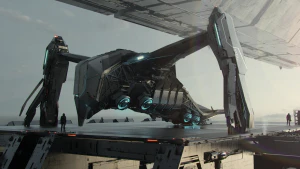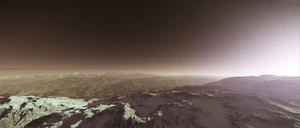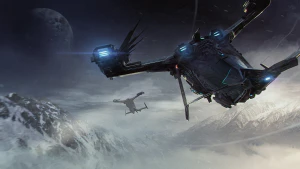Greetings Citizens!
November 2016 was one for the record books! We celebrated our fourth anniversary with a special ‘air show’-themed livestream featuring the return of everyone’s favorite Galactic Gear (now Galactic Tour!) host. We launched the long-awaited Prowler boarding ship and made great progress all around… which you can track in more detail than ever thanks to the weekly production reports we now share with the community.
Work continued on Star Citizen Alpha 2.6, 3.0 and Squadron 42 this month, with a focus on getting Star Marine ready for launch. We’ve been having an incredible time watching it come together, and we’re excited to let the Star Citizen community exerience the pitched FPS battles our Quality Assurance teams have been putting through their paces. Now let’s take a look back at the month that was November, 2016.
CIG LOS ANGELES
Engineering
With the push for 2.6, the team made huge progress on the vehicle system and flight control, while laying the groundwork for further development of the item system. Improved first-person radar mechanics should allow for new gameplay, and the first version of our atmospheric volume system was rolled out. Work continued on systems that support and control interactions, and tools for designers to flesh out the gigantic universe of Star Citizen.
Tech Design
Our tech design team continues to plug away supporting the engineers in their endeavor to get Item2.0 up and out the door. We also started putting some new ships through the pipeline. We can’t say which yet, but in the meantime, we’re very excited to finally release Drake’s Caterpillar and Herald. Last but not least we’ve been all hands on deck getting SC alpha 2.6.0 ready for public consumption as well as working with the various teams to put on a fun live stream.
Art
<embedvideo service="vimeo">195722152}}
The Art Teams have been dividing their efforts between Star Marine, Squadron 42 and the Persistent Universe. The Ship Team put the finishing touches on the Caterpillar and also moved onto the Drake Buccaneer making progress on the whitebox and now greybox of that ship. The Character Art Team worked on planetary fauna to add to the vast landscapes of our many planets as well as updating and working on humanoids by improving textures on the Outlaw and Marine BDUs, and have also created several new clothing items that you’ll soon see in the shops in the Persistent Universe. Both teams still have much more to do, so keep your eyes peeled for new additions!
Tech Content
The team was intensely focused on cleaning up the animation streaming system and unified the character head assets. Character Items were revisited and improved, setting the stage for the inventory system yet to come, and new scripts and pipeline tools will allow for artists and designers to bring even more to the ‘verse in coming builds. For the first time, asset and profiling fixes lead to zero asset build errors in the game.
Narrative
In the wake of last month’s motion capture shoot, the team worked with the editor to review the footage to put together selected footage for Chris to review. In anticipation of the November Live Stream, everyone pulled together to help script some of the events and segments while continuing to tackle any lingering 2.6 needs, the vast catalogue of items that are being created and chipping away at 3.0.
Will and Adam faced each other in the Electronic Access Invitational, causing much division and tension in the writer pit. Although the competition was resolved, hopefully they will start speaking soon.
Quality Assurance
<embedvideo service="vimeo">195722132}}
LAQA’s primary focus was on supporting local developers, and providing QA support and participating in the November Live Stream event. This involved a number of Star Marine and Arena Commander playtests. The team also took looks at the latest Afterburner and flight balance changes, as well as new missile systems that John Pritchett was working on. The team also enjoyed taking early looks at the new slate of ships for SC alpha 2.6.0: the Caterpillar, the Herald and even an extra-early look at the 85X.
LAQA also welcomed to the team a new tester: Andrew Hernando. Andrew joins us from Turtle Rock Studios, and he jumped in the deep end very quickly to get up to speed on the full scope of Star Citizen.
CIG AUSTIN
November has been a big month for Star Citizen. We have ramped up major testing on Alpha 2.6 and started adding Evocati playtesters as well. We provided a lot of technical support for the Anniversary Livestream and a ton of Player Relations and Platform support for the Anniversary sale which was a huge success! We’re looking towards the release of 2.6 now and the end of the calendar year, so here are some detailed updates from each team.
Design

The Austin Design Team has been looking ahead to 3.0.0. for the majority of November. Lead Tech Designer Rob Reininger took a trip out to LA to touch base with several of the Execs and Directors on various topics. He discussed the Shop Entity setup with Chris Roberts and Paul Reindell, presented the latest iteration on the Shopping Kiosk designs to Chris, and reviewed upcoming design requests for the Character Team with Josh Herman. He got some great feedback and has been doing another iteration on the Shopping Kiosk, working with the UI Team to get some good mockups.
We’re experimenting with “Shop Archetypes” for the better part of a month now. These archetypes are basically establishing fundamental parameters that every shop within a certain “type” will follow. Parameters include specific metrics that need to be followed, types of NPCs, prop requests, animation requests, and any gameplay considerations that need to be taken into account. The first batch of Shop Archetypes we’ve been addressing are “Bar,” “Clothing Shop,” “Security” and “Personal Weapons Shop.” There are several questions surrounding these various archetypes, so we’ve been having regular syncs with Tony Z and Todd Papy to answer these questions.
Designer Pete Mackay has been focused on the economy as it relates to 3.0. He’s been tweaking his Price Fixer tool, which takes varying gameplay aspects into account to generate value for items and components. These values will help to inform final in-game pricing for items and ships. Pete has also been defining various aspects of the “Commodities” list, distribution of said commodities, and how this informs the establishment of trade routes within the Stanton System.
Art
<embedvideo service="vimeo">195721702}}
Ship artists Chris Smith and Josh Coons are chugging away on their respective ships. Chris Smith is putting the final touches on the Hornet refactor and Josh is in the middle of Greybox pass for the Drake Cutlass refactor. Chris and Josh also took some time this month to create variants on the Hornet and Herald, the Wildfire and racing variants respectively. Emre Switzer has been hard at work at lighting the Star Marine maps, OP Station Demien Station and Echo Eleven.
Animation
<embedvideo service="vimeo">195721680}}
The PU Animation Team has been supporting Squadron 42 by implementing animations for the various Usables that have been set up in the Idris by Design. Bryan Brewer and David Peng worked on the Idris Deck Crew sequence, splitting up the various roles within the Deck Crew to be operated completely as AI. This is a very complex sequence that required a lot of back-and-forth with Design and it is looking really awesome. David and Vanessa have since been incorporating what we’re calling “lego piece transition” animations into the existing animation sets. These lego pieces were captured at Imaginarium Studios and, once stitched in to various animations, will allow AI characters to interact with Usables at more angles than they could previously. Right now we’re specifically working on stitching these into the Mess Hall and Sitting Console animation sets.
The Ship Animation Team wrapped up work on the Drake Caterpillar and Origin 85X this month in preparation for the 2.6 release. Jay Brushwood has since moved on to improving the GForces animations in the various cockpit types, taking into account improvements in other tech like Eye Stabilization to get them feeling really nice. Daniel Craig finished implementing all of the updated enter/exit combat speed animations this month as well.
Backend Services
The Backend Team spent the month delving into various areas of the project. Tom Sawyer has been fixing up bugs to help smooth out our lobby/matchmaking services. He is also supporting the UI Team in implementing the new Frontend Refactor of the Lobby, Matchmaking, and Leaderboard screens. Tom also created a new Leaderboard Service that grabs info from the website leaderboards and posts them in the new in-game Leaderboards.
Lastly, Ian Guthrie at Wyrmbyte helped implement some new admin commands that will help our LiveOps and Customer Support teams better navigate servers and identify problems. Ian is always a huge help and we’re grateful for all he has done on this project.
Quality Assurance
The first half of the month testing focused on Star Marine and Arena Commander to ensure they were ready for the November Live Stream. The second half of the month, the focus has been testing 2.6.0 and supporting multiple deployments to Evocati. We worked closely with Turbulent in a series of destructive tests of the new Spectrum website. Michael Blackard, Elijah Montenegro and Dash Wilkinson were tasked to assist the Animation department with special projects. This month we also welcomed Justin ‘Jub’ Bauer to the team.
Player Relations
If Player Relations is unfamiliar to you, it’s because it’s just been created! CIG Player Relations encompasses three areas: Game Support, E-Commerce Support (formerly Customer Service) and Community Support, with Will Leverett as Director of Player Relations overseeing the global department out of Austin, Texas, and Ray Roocroft managing the UK team.
We’ve worked hard to combine our US and UK support teams into a single organization that can mobilize to expedite support for the backers, and there was no better example than the work that the team did each and every day of the November Anniversary Live Stream and Sale. Special kudos go to Kraiklyn and CDanks for doubling up on live stream support.
We spent the later part of the month preparing 2.6.0 to go to the Evocati, and a very special thanks goes to Proxus, Mac, and George for their efforts in managing the test environments. They’ve spent countless nights and weekends working on Star Marine with our volunteer testers, and we’re excited that we’re getting close to pushing the build out to a wider audience.
IT/Operations
Network Services Manager Paul Vaden and IT Director Mike Jones spent time in LA with IT Manager Dennis Daniel in order to prepare for the November Live Stream event. For this live stream event, the IT team coordinated to build and deploy 12 gaming class systems that were used in the head to head matchups between Team Anvil and Team Aegis. Additionally, the IT team built a new live streaming solution capable of switching and mixing all players into the live stream plus cameras. Overall, it was an incredibly rewarding project, but the real credit goes to the video production team for pulling off a great show.
LiveOps/DevOps
2.6 was a huge focus this month as we prepare all our servers and publishing systems for Star Marine. While we completed several publishes to the Evocati, we deployed countless publishes internally for the QA teams across all studios to test on. With any major release there is a good amount of configuration and tuning that goes on behind the scenes. We really enjoy the early testing phases for this work. Special call out to Ahmed and his team, Andy, Nathan, and Jeffrey who have been putting in so much work on the publishing pipeline in order to streamline our internal publishes for flawless rapid deployment. This will be critical in the coming weeks as we roll out 2.6 to wider and wider groups.
FOUNDRY 42 UK
Art
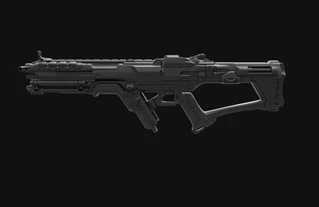
The big focus this month had to be the Prowler. It was a complex ship and we had a lot to deliver but the team did a great job. We didn’t get to rest on our laurels, though, as we had work to do on the 85X, MISC racing ship and Caterpillar promo. Work has begun on the Vanduul Stinger and the ship team has kicked off a major lighting pass on the Idris to make sure that our characters look amazing in the ship’s interior environment. Finally, several more rooms have been checked off the Javelin, leaving only a few left until the interior is complete.
We have three FPS weapons in concept. Plus, we have done a ton of previous work for more Klaus and Werner energy weapons. We have also done additional work with the Knightbridge Arms ship weapon family and fleshing out modular barrels.
In addition, we’ve been pushing heavily to close out 2.6, particularly the Star Marine maps OP Station Demien and Echo Eleven. As you can see, we’ve also continued to push along the visual development of our ‘surface outpost’ set as well as our planetary surface assets for the vertical slice level.
The team Behaviour focused on adding life to the three epic planets they’re working on. Each planet has now evolved from whiteboxed to textured and modelled environments. Although it may seem a lot of work is done, but more intensive work will be needed on the texture and composition to hit the look and feel we’re hoping to bring to the fans.
For Hurston, we focused on two areas, the interior streets and vista shots of the planet. For the interior streets, we wanted to create an oppressive feel for the general populace, so we added obstructed skylines, narrow alleys covered with machinery, ever present security checkpoints, and expressionless statues looking down towards the streets.
For MicroTech, we reduced the size and scale of our plan and focused on one dome only in an effort to make the planet a more feasible endeavor, while maximizing the visuals.
For Crusader, we worked especially hard in utilizing the building silhouettes and gaps between buildings to present breathtaking vista shots on the skylines. We also spent time on the background buildings of the map to complement the planetary vista, which offers a nice balance between the natural environment and human technology.
VFX
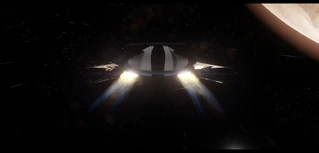
This month, the VFX team finished a full pass on two of the new ships going into 2.6 including the 85X and the Caterpillar. For Star Marine, we completed a final optimization pass for the Demien and Echo Eleven maps including destructible props and surface type impacts, implemented a new VFX pass on the energy shotgun (changing the rounds from electricity to plasma) and did an initial pass on dead player fadeout VFX.
We did a huge clean-up of ship and fps weapons, implementing a new projectile shader created by the Graphics team and improved missile effects to tie in better with the new missile assets. In a bit of administrative work, we also cleaned up our library of generic particles. It’s always nice to do a little spring-cleaning to makes sure the team can find elements quickly.
Design
<embedvideo service="vimeo">195721977}}
Most of the S42 designers have been working out of our Frankfurt office throughout November in an effort to work as efficiently as possible with the system designers that are helping with the Subsumption implementation. Obviously, the tech is still being developed, but the process is really paying off and we are starting to get behavior types into the game. The Vertical Slice level is still enabling us to prove out gameplay mechanics that will allow designers to polish up the graybox missions and the intense focus on small details is making a big difference across the board.
The guys working on 2.6 are fixing bugs and last second polish actions that will hopefully make it into your hands very soon.
Audio
This month the Audio department, like the rest of the team, was pretty heavily focused on Star Marine and other 2.6 needs. For 2.6 we finished up audio for the Caterpillar and 85X which included everything from thrusters and moving parts to extensive work on the internal ambience around the ship. For Star Marine, we created and implemented ambient and environment sounds for the levels, weapon sounds, player sounds and ambient music. Extensive work was also done to include announcers for the teams.
We also continued working on Squadron 42 which included (without getting into specifics): developing our outsourced editorial pipeline to handle the massive amount of dialogue that’s been recorded, optimizing the AI battle chatter code, working on the ambient and cinematic music.
For the PU and Arena Commander, we did an overhaul on the Announcer and Ship Computer Systems, including the implementation of a Ship Computer Verbosity setting into the options menu, and fixed some issues where sound was dropping out during Quantum travel and during some weapon fire.
UI
Since last month, the UI team has been continuing work on the implementation of the new front-end menus and Electronic Access lobbies. The entire front-end flow is now mostly in a functional state, and the artists have been working on furthering the visual polish and animations for each screen. We’ve also been working on both the Star Marine and Arena Commander loadout interfaces – for ship customization, we’ve got 3D holo-objects rendering in the UI with smooth rotation and zooming. The work we are doing here will also eventually serve as the base system for the revamped in-world holotable interface.
Since the live stream, we’ve also made additional headway with regard to the Star Marine game HUD – which includes better AR callouts for friendly players, offscreen icon boundaries, as well as improved rendering of the 2D UI. We have also designed 3D icons for in-game pickup items in Arena Commander. We have also started working on insignia designs for Star Marine and Arena Commander leaderboard rankings.
Programming
Again working hard on all the features and polish for 2.6 and on the FPS for the Star Marine games. In Arena Commander we’ve now implemented the missile and ammo pickups. We also continued work on the new camera system including the new spectator cam mode.
The team is also working hard on the Arena Commander mega map. Most of the work required for the dynamic gamerules has been completed, and now it’s at the testing stage to find what still isn’t working and fix it up. The lobby refactor means we can now connect and disconnect to a server without having to completely load and unload a whole map, which we hope will make a big and positive difference for you while creating and joining Arena Commander matches.
On the networking side we’re making great progress with the message queue rewrite, serialised components, the lobby refactor and entity bind culling.
Graphics
<embedvideo service="vimeo">195721952}}
The depth of field effect is getting a complete overhaul to vastly improve its speed (up to 10x faster in some cases). We’re fine tuning the shadow system to achieve greater shadow resolution and many more shadows through the introduction of static shadow maps for the environments, with the focus being on achieving cinematic quality lighting on SQ42 in-game rather than just in hand crafted cut-scenes. We’ve also started on a major upgrade of the bounced light system (global illumination) with the first step being the GPU acceleration of reflection/cube-map captures to remove the previous offline/CPU system.
Animation
We have been mostly supporting the upcoming Star Marine release. There has also been continued work on AI combat animation assets so that the design and programming teams can get core functionality implemented and ready for the next round of animation iteration.
All existing base weapons have been through a second animation pass. Reloads are improved, as well as hand positioning and various other tweaks. There has been some further work done on previz for the next round of weapons that are due to come down the pipeline. Legacy weapons have been spruced up for the initial Star Marine release with improved hand positioning and firing animations.
The prone animation set is being looked at with a view to implementing some big improvements. Core poses will be updated and transitions to and from different stances are prepped and ready to be worked on.
We have a new animator based in the Frankfurt studio that is mainly going to be working with the design and code team on getting AI functionality looking and feeling good. There has been progress made on player combat signals as well as AI reactions to danger / sounds.
Quality Assurance
To help with 2.6.0 feature testing and preparation for the live stream, we split our team into three groups, with Liam leading the Squadron 42 testing, Mike leading Arena Commander and Crusader testing and Nathan leading Star Marine testing, with the help of our FPS specialist Mark Tobin. The testing required a lot of cross studio communication and team building as we worked on filling servers to ensure we had a steady platform to push to the Evocati shortly after the live stream. For the live stream itself our efforts came together, testing the new flight balances put in by the tech team and the new ships, we had several dry runs of what we showed to ensure it all went off without a hitch.
FOUNDRY 42 DE
Cinematics
<embedvideo service="vimeo">195721828}}
For the SQ42 campaign we’re continuing work on video comms and several conversational scenes, cleaning and editing the required animations as well as setting up and lighting them. We also experimented with a camera/character based lighting rig, as we’ll have the challenge that some conversations can happen in very dark alcoves/corridors or other non-controlled situations where we might want more filmic light shining on the scene.
We also completed the 10 separate “Galactic Tour” segments for the Anniversary Live Stream. Those featured already established lore character Jax McCleary visiting the 2946 Intergalactic Aerospace Expo. Jax used a modified Tier 2 character head and, as time was critical, only had some basic animation cleanup done for body and face. For the Expo, we built the ex-Navy airbase and hangars that got converted into show floor halls. Different ship manufacturers got a 3D version of their logo, including Drake, Aegis, Anvil and RSI.
VFX

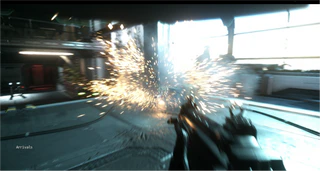
During the past month, the Frankfurt VFX work has been focused on polishing effects for the 2.6 release. These included full environmental VFX passes on several of the levels as well as some effects created specifically for the FPS aspect of the game, like several new variations of blood impacts for when the player is shot, screen effects for player damage that are triggered via flowgraph and a new MK4 frag grenade explosion.
Quality Assurance
DEQA’s main focus for November was Star Marine, Squadron 42, as well as testing new engine-side features. Chris Speak and Glenn Kneale spent a majority of the month working on Star Marine ad-hoc testing and regression, with Glenn also tackling Squadron 42 testing and AI sync meetings. We also participated in multiple playtests not only once but sometimes three or four times per day, ranging from dev playtests to cross studio playtests with our offices in UK, ATX, and LA. Chris also worked on creating various test levels for the dev team to use for their own feature testing. Melissa Estrada has been working closely with Chris Bolte to test his newly developed integrated page heap for our Game Dev builds that will allow us to capture more robust crash core dumps for our engineers. These core dumps will provide much more information for an engineer to use when resolving low reproduction crashes, which is a win-win for bug smashing and for improving overall gameplay. Chris Bolte made this process much simpler, so that anyone in QA will be able to provide these core dumps when requested for a specific crash. Melissa also spent time learning and testing Sascha Hoba’s planet editor together with Pascal Muller, in order to formulate a new checklist that will specifically check the planet editor’s core functionality to ensure that it continues to be in working order for our environment artists.
Environmental Art
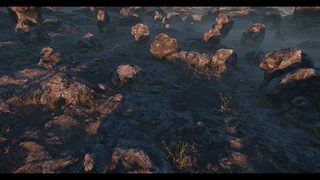
This month the DE Environment team grew by a few people, so the senior staff spent time getting them acquainted to our internal processes. The existing team is primarily focused on procedural planets tasks: defining and creating bespoke ecosystems like canyons and mining pits, improving the blending of the terrain materials to get more detail, and iterating on the tools to make the workflow more efficient. They also worked on various megastructures for a SQ42 level, including modelling, UV mapping and making prefabs out of the components for the designers to place.
Tech Art
<embedvideo service="vimeo">195721856}}
Like many other departments, Tech Art spent the month supporting 2.6 as well as S42. The team worked with Designers and updated a large amount of animation for FPS, especially improving select, deselect, and reloads. They updated and re-exported numerous weapons and gadgets to accommodate the new left hand grip pose, which is now functioning using runtime IK. We also completed our new weapon pre-visualization pipeline which enables our modelling department to test their WIP weapons directly in a game, this allows them to quickly review and identify any potential issue a weapon may have.
Engineering
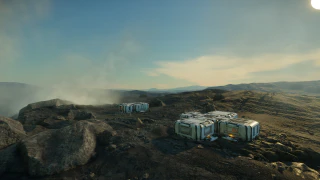
The engine team has almost too much to post, which is a good thing, so let’s start with the high-level stuff. We made some general improvements on Physics, Shader system, Texture Array Streaming, Animation Ragdoll and Terrain/Ecosystems. One of the tools allowed artists to punch holes into planet terrain for smoother embedding of large mass structures which will come in handy for landing areas. We also switched to a multi-threaded memory allocator which will not only increase efficiency, but unify the use across the engine, game, tools and editor.
We improved the reprojection based occlusion systems by cleaning up the previously existing code and converting it to pure SSE2 SIMD (allows us later to select the best SIMD variant supported on the user’s CPU). While doing so, we also fixed some aliasing problems inside the occlusion code which results in a more stable frame during movement. Then we spent some time doing a massive clean-up of our Zone transition code. Over the time this part had become very complex, but we managed to get the complexity down again which made our zone transitions more stable. Before the update, the client code had to find out if an object had changed zones, which was very fragile. Now the code is explicit, so that all objects change zones as an automatic operation. In addition, this is also synced with physics which should fix (or at least improve a lot) the cases of players being teleported to space when entering/leaving ships.
We also improved our low level memory redirection functionality; we managed to get rid of some layers making the code more understandable. Building on this clean-up, we changed our core system allocators, so far we had used a custom allocator for small allocations and the OS allocator for larger ones. Problem was that this design is several years old. In practice, this means that the OS allocator can now perform small allocations as well as our allocator, but instead of going OS allocator only, we went with JeMalloc. This is the system allocator used by FreeBSD and backed by Facebook. JeMalloc follows a more modern design so that it scales very well with multiple threads, something which is important for us and will be more important as we parallelize more and more code.
We also continued working on our Area system. Areas are a special mark-up used by the game designers to give rooms or areas some specific context. The engine can report when entities enter or leave such an area. We have now extended this system to track the overlapping status of all entities within all areas. To implement this in a way that it works with our massive scale (in number of entities and areas), we moved the old system directly into the zone system, which allows us to reuse spatial information for a much more efficient algorithm.
Weapons
Over the last month, the FPS weapon artists polished weapons and gadgets for upcoming releases, built prototypes for a whole range of new Kastak Arms guns, and spent some time making modular irons sights for the P8 weapon family. We completed the first pass art for the new re-worked ATT-4 laser rifle, and started the same process for the Arrowhead sniper rifle. The ship weapon team has been blocking out a new range of ship weapons based on the updated Knightbridge Arms manufacturer style which will include a more modular design.
Level Design

The Level Design team in Frankfurt is hard at work on the locations required for 3.0, this involves building out space station archetypes and satellite variants as well as a few surface outposts. We are also looking into supporting the art team on the larger planetary landing zones, as well as progressing on a modular approach for our locations. Satellites and surface outposts are shaping up nicely and have been passed onto the art team.
System Design
This month system design was busy setting up usable records for Squadron 42, which will lay the groundwork for cinematic scenes and player interactions, adding background conversations between AI and in general making AI feel a lot more alive and natural in their environment. At the same time, we worked on finalizing the Mercenary and Bounty Hunter careers for 3.0 and breaking these careers into their component systems. We also made progress on the AI skills and stats system which should allow each AI to have an individual personality, individual needs and wants. Generally based on these skills and stats, an AI will change the priority of their Subsumption behaviors. For example, if an AI is ordered to fix your ship, he might not do that if he needs to go to the toilet or if he is too tired. It will also encourage the players to crew their ships with AI who have a variety of skills for every situation, and set up teams based on how all of these guys complement each other for the task at hand.
AI
We made great progress on AI this past month. At the beginning of the month we completed the first pass on Mission Functions and Mission Callbacks. A mission in Subsumption will first start with an Init function and will end with Uninit to allow designers to both prepare and clean-up their logic. Let’s assume we create a new test mission where we want to spawn Captain White in the Bridge, the Init function will look like this.
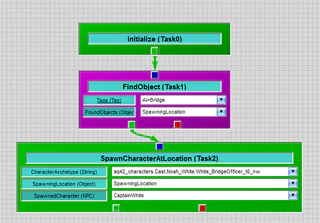
Functions for a Mission can either be called by the AI code (like the Init above), or can be dynamically created by designers, and they can be imagined as mission local functions. As you can see in the picture the Captain White character is now stored into the “CaptainWhite” variable, that is the NPC type, which carries information about what the game code can communicate to the Mission System in regards to the element that it stores. An NPC variable can, for example, call back the mission system when the NPC health changes, when the NPC dies, when he gets healed and so on. If we want to react to situations in which the health of Captain White is changed, then we can add a mission callback, as in the following picture.
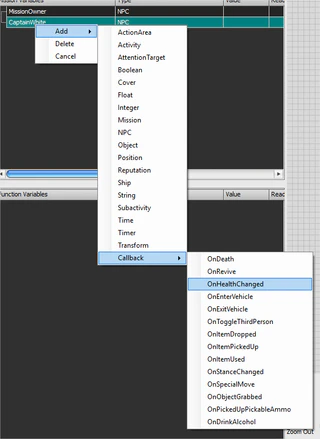
The more callbacks that are exposed from the game code, the more events a designer can react to and create his own logic. Also the Subsumption Mission system (as Subsumption in general) allows game programmers to define any type in the game code, allowing the system to be easily extended without any need to modify the core code. Callbacks can also be specified as global, for example, we can have specific logic when any NPC dies during a mission. Those are what we call “Global Callbacks”.
For Subsumption, we also made new improvements to the Combat behaviors. Combat is a very different element for the NPC behaviors, since it requires a lot of coordination between the characters and specific analysis. We created a new Combat activity (based on the work we have done in the previous months), so that the designers can utilize it for any case in which a hostile is detected by an NPC character. The first combat reaction is something that happens when an NPC thinks he saw something dangerous: his behavior will change based on how sure he is that the thing he saw is an actual danger for himself. For example, an NPC that see the player at a far distance, won’t react immediately to the threat, he will try to look in the direction of the player and understand if what he sees can be a threat, and if so he can communicate to the other member of his group and then start to attack the enemy. This is the state that allows the player to decide his approach, he is almost detected, but he can still try to hide, approach from a different angle or, for example, try to take down the enemy before he informs his friends.
For combat and non-combat environments we have introduced an “Emotion component” to allow the ability to control facial animations based on the emotion of the NPC. We also worked on improving the animation flows to allow proper blending between states and make sure the characters feel more fluid during the gameplay. We also did some work on ground turrets to make sure that they can easily be controlled by the AI and execute proper behaviors. In addition to all the above, we made progress on improving stability and fixing existing bugs.
TURBULENT
For those of you who are new to Star Citizen, Spectrum is an integrated communication platform that includes forum, chat, private messaging, and notifications. Future versions will include additional features like voice chat and in-game overlay.
We were excited to release Spectrum (alpha v.0.1) to members of the Evocati test group. Having the “Avocados” test the communication platform and give feedback to us has been invaluable. We are planning to expand the testing group to include more and more backers, finally culminating in a full release on the site for all backers in the new year.
This past November has been an incredibly busy month when it comes to ships and ship sales. At the end of the month the Anniversary sale was kicked off with the Galactic Tour series, which featured a new manufacturer each day, offering up their ships for sale. During the sale we saw not only older ships making a comeback, but new ships as well, including four new variants, the 85X and the sleek Tevarin dropship, the Prowler! The Anniversary sale was capped off by the return of all manufacturers and ships to the sales floor for a two-day Grand Finale.
THE WRAP-UP
Looking Ahead
That’s it for November, 2016! Watch this space for additional updates, and please continue to check our production reports for the status of Alpha 2.6 and Star Marine. We’re also ending our broadcast year with a holiday livestream later today; tune in to help us bid adieu to 2016!
